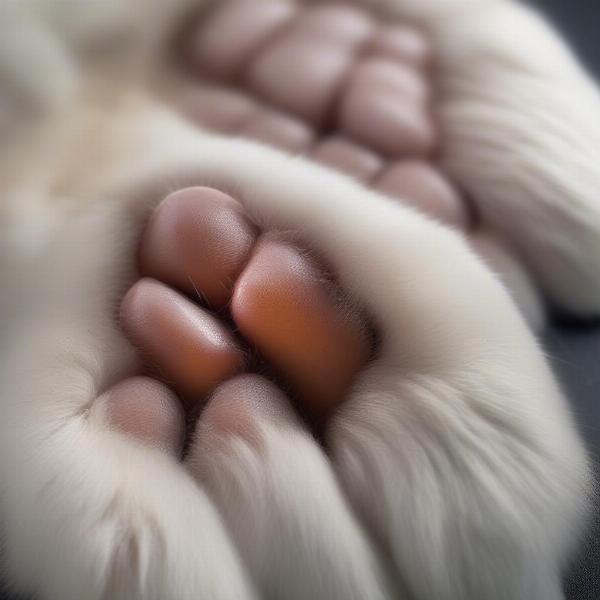Betadine, a common household antiseptic, is often reached for when our furry friends get scrapes or cuts. But is betadine for dogs truly safe and effective? This article will delve into the uses, benefits, and potential risks of using Betadine on your canine companion, providing you with the information you need to make informed decisions about their care. We’ll cover everything from appropriate applications to potential side effects, ensuring you’re equipped to handle minor wounds and injuries with confidence.
Understanding Betadine and Its Uses on Dogs
Betadine, also known as povidone-iodine, is a topical antiseptic that kills a broad range of bacteria, fungi, and viruses. Its use in veterinary medicine is widespread, making it a go-to solution for many dog owners. While generally safe, understanding its proper application is crucial. Overuse or misuse can lead to skin irritation or other complications.
When to Use Betadine on Your Dog
Betadine is effective in treating a variety of skin conditions in dogs. Superficial cuts, scrapes, abrasions, and minor burns can benefit from Betadine’s antiseptic properties. It can also be used to disinfect hot spots, ringworm infections, and other localized skin issues. However, it’s important to remember that Betadine is for external use only and should never be ingested. saline dog
How to Apply Betadine to Your Dog
Before applying Betadine, clean the affected area with warm water and mild soap. Pat the area dry with a clean towel. Then, dilute the Betadine solution with sterile saline or water, typically in a 1:10 ratio. This reduces the risk of skin irritation. Apply the diluted solution to the wound using a cotton ball or gauze pad. Avoid scrubbing or applying excessive pressure. Allow the area to air dry. Repeat the application two to three times daily, or as directed by your veterinarian.
Potential Risks and Side Effects of Betadine for Dogs
While generally safe, Betadine can cause skin irritation in some dogs, especially if used undiluted or too frequently. Signs of irritation include redness, swelling, and itching. If you notice any of these symptoms, discontinue use and consult your vet. In rare cases, dogs can have an allergic reaction to iodine, the active ingredient in Betadine. This reaction can manifest as hives, difficulty breathing, or facial swelling.  Dog paw with Betadine applied
Dog paw with Betadine applied
When to Consult Your Veterinarian
If your dog’s wound is deep, heavily bleeding, or shows signs of infection (pus, foul odor), consult your veterinarian immediately. betadine and dogs Do not attempt to treat these conditions at home. Also, if your dog’s skin condition doesn’t improve after a few days of Betadine treatment, seek professional veterinary advice. They can determine the underlying cause and recommend the most appropriate treatment plan.
Alternatives to Betadine
Several alternatives to Betadine can be used to cleanse minor wounds in dogs. These include chlorhexidine solution, which is another effective antiseptic, and saline solution, a gentle option for cleaning sensitive areas. pet urns for dogs Always consult with your veterinarian before using any new product on your dog, especially if they have pre-existing skin conditions.
Conclusion: Using Betadine Safely and Effectively
Betadine can be a valuable tool in your dog’s first-aid kit, providing effective antiseptic action for minor wounds and skin irritations. However, responsible use is key. Always dilute the solution, monitor for side effects, and consult your veterinarian when in doubt. By understanding the proper application and potential risks of betadine for dogs, you can ensure its safe and effective use in promoting their health and well-being.
FAQ
- Can I use human Betadine on my dog? Yes, but ensure it’s a 10% solution and always dilute it before applying.
- How long does Betadine take to work on dogs? Betadine starts working immediately upon contact, killing bacteria and other microorganisms.
- Can Betadine stain my dog’s fur? Yes, it can temporarily stain light-colored fur. The stain will usually wash out with regular shampooing.
- What should I do if my dog licks the Betadine? While small amounts are unlikely to cause serious harm, contact your vet immediately if you suspect your dog has ingested a significant amount of Betadine.
- Can I use Betadine on my dog’s paws? Yes, diluted Betadine can be used on a dog’s paws for minor cuts and abrasions. betadine dog paws
- Is Betadine safe for puppies? Yes, but always consult with your veterinarian before using Betadine on puppies, as their skin is more sensitive.
- What if my dog has an open wound? Consult your veterinarian for deep or heavily bleeding wounds. iodine for dog paws Do not use Betadine on deep wounds without veterinary guidance.
ILM Dog is your trusted source for comprehensive dog care information and expert advice. We offer a wide range of resources, from breed selection to health and wellness, nutrition, training, grooming, and much more. Our goal is to empower dog owners worldwide with the knowledge and tools they need to provide the best possible care for their canine companions. Learn more about how we can help you and your furry friend thrive by contacting us via email at [email protected] or by phone at +44 20-3965-8624. Visit ILM Dog today!